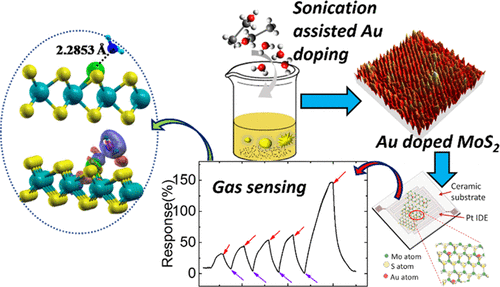Our official English website, www.x-mol.net, welcomes your feedback! (Note: you will need to create a separate account there.)
Substitutional Doping of MoS2 for Superior Gas-Sensing Applications: A Proof of Concept
ACS Sensors ( IF 8.9 ) Pub Date : 2021-09-08 , DOI: 10.1021/acssensors.1c01258 Debasree Burman 1 , Himadri Raha 2 , Bibhas Manna 3 , Panchanan Pramanik 4 , Prasanta Kumar Guha 3
ACS Sensors ( IF 8.9 ) Pub Date : 2021-09-08 , DOI: 10.1021/acssensors.1c01258 Debasree Burman 1 , Himadri Raha 2 , Bibhas Manna 3 , Panchanan Pramanik 4 , Prasanta Kumar Guha 3
Affiliation

|
Two-dimensional layered materials (like MoS2 and WS2) those are being used as sensing layers in chemoresistive gas sensors suffer from poor sensitivity and selectivity. Mere surface functionalization (decorating of material surface) with metal nanoparticles (NPs) might not improve the sensor performance significantly. In this respect, doping of the layered material can play a significant role. Here, we report a simple yet effective substitutional doping technique to dope MoS2 with noble metals. Through various material characterization techniques like X-ray diffraction, scanning tunneling spectroscopy images, and selected area electron diffraction pattern, we were able to put forward the difference between surface decoration and substitutional doping by Au at S-vacancy sites of MoS2. Lattice strain was found to exist in the Au-doped MoS2 samples, while being absent in the Au NP-decorated samples. Surface chemistry studies performed using X-ray photoelectron spectroscopy showed a shift of Mo 3d peaks to lower binding energies, thus realizing p-type doping due to Au. The blue shift of the peaks as observed in Raman spectroscopy further confirmed the p-type doping. We found that gold-doped MoS2 was more sensitive and selective toward ammonia (with a response of 150% for 500 ppm of ammonia at 90 °C) as compared to gold NP-decorated MoS2. The advantages of substitutional doping and the gas-sensing mechanism were also explained by the density functional theory study. From the first principles study, it was found that the adsorption of Au atoms on the S-vacancy site of a monolayer of the MoS2 sheet was thermodynamically favorable with the adsorption energy of 2.39 eV. We also successfully doped MoS2 with Pt using the same technique. It was found that Pt-doped MoS2 gives huge response toward humidity (60,000% at 80% relative humidity). Thus, various noble metal doping of MoS2 selectively improved the sensing response toward specific analytes. From this work, we believe that this method could also be useful to dope other layered nanomaterials to design gas sensors with improved selectivity.
中文翻译:

用于卓越气体传感应用的 MoS2 替代掺杂:概念验证
在化学电阻气体传感器中用作传感层的二维层状材料(如 MoS 2和 WS 2 )具有较差的灵敏度和选择性。仅仅使用金属纳米粒子 (NP) 进行表面功能化(材料表面的装饰)可能不会显着提高传感器性能。在这方面,层状材料的掺杂可以发挥重要作用。在这里,我们报告了一种简单而有效的替代掺杂技术来掺杂 MoS 2与贵金属。通过X射线衍射、扫描隧道光谱图像和选区电子衍射图案等各种材料表征技术,我们能够提出表面装饰和Au在MoS 2的S-空位位置的替代掺杂之间的区别。发现Au掺杂的MoS 2样品中存在晶格应变,而Au NP装饰的样品中不存在晶格应变。使用 X 射线光电子能谱进行的表面化学研究表明,Mo 3d 峰向较低的结合能移动,从而实现了由 Au 引起的p型掺杂。在拉曼光谱中观察到的峰蓝移进一步证实了p型掺杂。我们发现掺金的 MoS 2与金 NP 修饰的 MoS 2相比,对氨的敏感性和选择性更高(在 90 °C 下对 500 ppm 氨的响应为 150%)。密度泛函理论研究也解释了替代掺杂的优势和气敏机制。从第一性原理研究发现,Au原子在MoS 2单层的S空位上的吸附在热力学上是有利的,吸附能为2.39 eV。我们还使用相同的技术成功地将 MoS 2与 Pt 掺杂在一起。发现 Pt 掺杂的 MoS 2对湿度有很大的响应(在 80% 的相对湿度下为 60,000%)。因此,MoS 2的各种贵金属掺杂选择性地改善了对特定分析物的传感响应。从这项工作中,我们相信这种方法也可用于掺杂其他层状纳米材料,以设计具有更高选择性的气体传感器。
更新日期:2021-09-24
中文翻译:

用于卓越气体传感应用的 MoS2 替代掺杂:概念验证
在化学电阻气体传感器中用作传感层的二维层状材料(如 MoS 2和 WS 2 )具有较差的灵敏度和选择性。仅仅使用金属纳米粒子 (NP) 进行表面功能化(材料表面的装饰)可能不会显着提高传感器性能。在这方面,层状材料的掺杂可以发挥重要作用。在这里,我们报告了一种简单而有效的替代掺杂技术来掺杂 MoS 2与贵金属。通过X射线衍射、扫描隧道光谱图像和选区电子衍射图案等各种材料表征技术,我们能够提出表面装饰和Au在MoS 2的S-空位位置的替代掺杂之间的区别。发现Au掺杂的MoS 2样品中存在晶格应变,而Au NP装饰的样品中不存在晶格应变。使用 X 射线光电子能谱进行的表面化学研究表明,Mo 3d 峰向较低的结合能移动,从而实现了由 Au 引起的p型掺杂。在拉曼光谱中观察到的峰蓝移进一步证实了p型掺杂。我们发现掺金的 MoS 2与金 NP 修饰的 MoS 2相比,对氨的敏感性和选择性更高(在 90 °C 下对 500 ppm 氨的响应为 150%)。密度泛函理论研究也解释了替代掺杂的优势和气敏机制。从第一性原理研究发现,Au原子在MoS 2单层的S空位上的吸附在热力学上是有利的,吸附能为2.39 eV。我们还使用相同的技术成功地将 MoS 2与 Pt 掺杂在一起。发现 Pt 掺杂的 MoS 2对湿度有很大的响应(在 80% 的相对湿度下为 60,000%)。因此,MoS 2的各种贵金属掺杂选择性地改善了对特定分析物的传感响应。从这项工作中,我们相信这种方法也可用于掺杂其他层状纳米材料,以设计具有更高选择性的气体传感器。


























 京公网安备 11010802027423号
京公网安备 11010802027423号